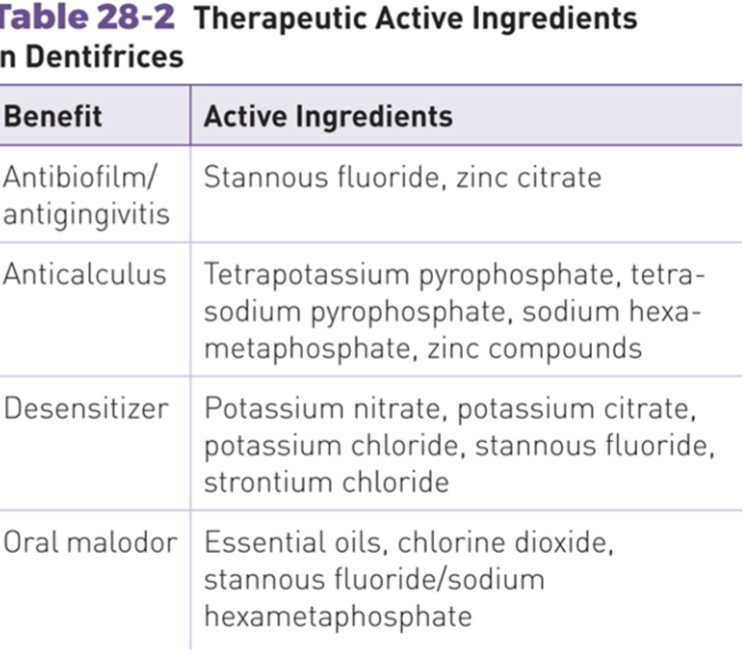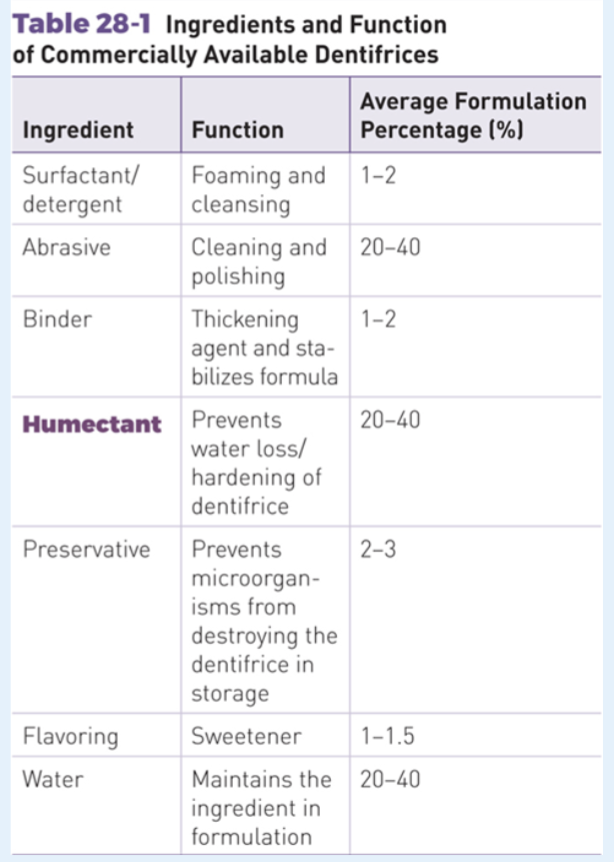Prevention of Dental Disease Final Review
1/9
There's no tags or description
Looks like no tags are added yet.
Name | Mastery | Learn | Test | Matching | Spaced |
|---|
No study sessions yet.
10 Terms
what types of stimuli elicit a pain reaction in patients with dentinal hypersensitivity
a definitive characteristic associated with dentinal hypersensitivity is plain elicited by a stimulus and alliviated upon its removal
tactile-touch
thermal- temerpatire
evaporative - air
osmotic -sudden movement of fluid within the exposed dentinal tubules due to osmotic changes, such as from sugary or acidic foods.
chemical
what causes of dentinal hypersensitivity
dentin is composed of fluid-filled dentinal tubules
that narrow and branch as they extend
from the pulp to the dentino enamel
junction or from the pulp to the
dentino cementum junction Only the portions of dentinal tubules
closest to the pulp are potentially
innervated with nerve fiber endings
from the pulp chamber Tubules are wider and more numerous
in sensitive areas
the pulp highly innervated with nerve cell fibers
endings that extend just beyond the
deninopulpal interface of the dentinal
tubules
what are the different types of tooth wear and what their causes are
Gingival recession and Root exposure
● Loss of Enamel and Cementum
● Attrition, Abrasion, and Erosion
● Abfraction - Lateral occlusal forces stress the enamel
rods at the cervical area, resulting in
enamel rod fracture over time. In an
advanced stage, a wedge- or V-shaped
cervical lesion is visible. Although minute
cracks in the enamel rods may not be
clinically evident, the tooth can exhibit
hypersensitivity.
● Other factors
○ Dental procedures
○ Instrumentation
○ Frequent/Improper stain removal
techniques
○ Root caries
○ Enamel stripping
what is the definition of Hydrodynamic theory
Stimulus at outer aspect of dentin will
cause fluid movement within dentinal
tubules
○ Creates pressure on nerve endings
within dentinal tubules
○ Transmits pain impulse by stimulating
nerves in pulp
what are desensitizing agents and how they work
to stop nerve transmission
Potassium Salts - depolarizing the nerve endings in the teeth
● Fluorides- blocking the small, hollow tubes in your teeth called dentinal tubules
● Oxalates - primarily stop nerve transmission by blocking the open dentinal tubules that lead to the tooth's nerve center, the pulp
● Glutaraldehyde - glutaraldehyde prevents nerve transmission by coagulating proteins in the dentinal fluid, which creates a physical plug that blocks the nerve-stimulating fluid flow inside the dentinal tubules
● Calcium Phosphate Technology- Calcium phosphate technology stops dental nerve transmission by physically blocking the dentinal tubules that lead to the tooth's nerve. By occluding these microscopic channels
Dentifrices
● Gels
● Mouthrinses
what professional desensitizing methods can be completed in the
dental office
Tray-delivered fluoride agents
● Fluoride Varnish
● 5% Glutaraldehyde
● Oxalates
● Unfilled or partially filled resins
● Dentin-bonding agents
● Glass ionomer sealants/restorative
materials
● Soft-tissue grafts
● Lasers
which active ingredient applies to specific patient needs, such as dentinal hypersensitivity, anti-tarter (calculus reduction)etc.

definition of sustainability
substantivity is the ability of a product, like a mouthwash or root canal irrigant, to remain on or in the tissues (like dentin) and provide a long-lasting antibacterial effect after its initial application. This property is crucial for products to maintain their therapeutic action over time, so that a single use can continue to provide benefits, such as reducing bacteria in the oral cavity or inside a tooth's canal
what are all of the applications of Stannous Fluoride
STAINING
Deposition of fluoride ion on enamel -
tin ion interferes with cell
metabolism/antimicrobial effect.
Reduction of oral malodor (halitosis)
Certain ingredients can reduce the production of volatile sulfur compounds (VSCs)
Chlorhexidine (CHX), cetylpyridinium chloride (CPC), and zinc
Stannous fluoride combined with hexametaphosphate
Know all of your abrasive agents, and the functions of each added agent in
toothpaste and mouth rinse (foaming agents, binders
or thickeners, malodor, etc.)
Detergents (foaming agents or surfactants)
Cleaning and polishing agents (abrasives)
Binders (thickeners)
Humectants (moisture stabilizers)
Preservatives
Flavoring agents (sweeteners)
